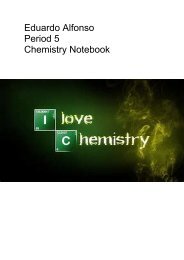You also want an ePaper? Increase the reach of your titles
YUMPU automatically turns print PDFs into web optimized ePapers that Google loves.
Here are some examples for you:<br />
Zn 2+ is zinc. S 2- is sulfide. Put them together for zinc sulfide (ZnS).<br />
Here's another:<br />
K2O is potassium oxide<br />
Naming Ionic Compounds Containing Transition Metals<br />
A transition metal is a metal that can use the inner shell before using the outer shell to bond. These<br />
are the elements in the middle of the periodic table - things like zinc, iron and copper. Naming<br />
polyatomic ionic compounds that have transition metals in them is also fairly easy. It follows the same<br />
naming rules as the simple binary compounds, but with an extra rule added in. So, you still name the<br />
cation first, followed by the anion with the suffix -ide added to the end of it.<br />
The new rule is that transition metals form more than one ion, so this has to be accounted for in the<br />
naming. We do this by using Roman numerals to denote which ion it is. The Roman numeral will<br />
equal the charge on the ion. For instance, Fe 2+ is iron (II). Fe 3+ is iron (III).<br />
When compounds are formed with these metals, the different ions still have to be accounted for. If I<br />
told you the compound was iron chloride, that wouldn't give you the full story. You wouldn't know if it<br />
was iron (II) or iron (III), which means you don't know how many chlorine atoms are in the compound<br />
to bond with the iron, since two chlorines would be needed for iron (II) and three for iron (III). If I<br />
instead told you that the compound was iron (II) chloride, you would know that it was Fe 2+ in there,<br />
which means you have two chlorine atoms bonding with it. The formula would be FeCl2. If I said it<br />
was iron (III) chloride, the formula would be FeCl3.<br />
Naming Polyatomic Ionic Compounds<br />
A polyatomic ionic compound is a compound made up of a polyatomic ion, which is two or more<br />
atoms bonded together, and a metal. Naming polyatomic ions is harder, but doable. First, name the<br />
cation, which is just the name of the element. Next, name the anion. This gets trickier.<br />
Notes Section:<br />
you must first figure out all of the ions and then put them together<br />
you must combine the a and d terms, and combine the c and b terms<br />
64



